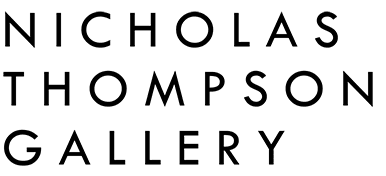KYLIE BANYARD AND JESSIE BOYLAN’S LA TROBE ART INSTITUTE BIANNUAL FACADE COMMISSION FEATURED ON ABC CENTRAL VICTORIA
Bendigo Creek doesn’t get a lot of love or appreciation, as to most people it just looks like a big concrete and bluestone drain directing any surplus rainwater away from homes, businesses and roads in the regional Victorian city’s CBD.
But parts of the creek still look like a natural waterway, just 13 kilometres north of the city at Huntly Streamside Reserve, not far from Bendigo’s livestock saleyards. It meanders along, dotted with trees and vegetation, alive with insects and birdlife beside a clearing of long grass.
It’s here that local artists Jessie Boylan and Kylie Banyard found inspiration for their piece, Rising gently about here, now featured on the façade of the La Trobe Art Institute gallery in Bendigo’s View Street.
The large image, viewed best at night, glows like a ghostly reminder of pristine pre-colonial habitat but also a hint of futuristic fantasy, an artistic “re-wilding” that perhaps isn’t far off actual plans by the local council to re-imagine the creek as a bike and pedestrian-friendly public space.
The rivers in our lives
Mx Boylan and Dr Banyard were interested in exploring the changes to the waterway with historical and contemporary photographs, maps, topographical drawings, oil paint and watercolour.
“It was actually in the middle of lockdown, and we had to start our research on Google Maps, just trying to follow the creek on a screen and discovered how far the creek stretches and where the creek meets other bodies of water,” Dr Banyard said.
“We realised that we could come to Huntly where it opens up, so we met here one day for a walk and had a look around and started to research this area and taking images.”
For Mx Boylan, it was an extension of previous work they had done across Australia and Papua New Guinea looking at the impacts of mining on rivers, landscapes and communities.
“We don’t consider how much they’re connected to other bodies of water, and how much they impact our life and how much history is contained within the sediment and layers.”
Sifting through layers
It was a map created by gold miner William Sandbach in 1851, describing the rhythms of the landscape around the creek, that gives the artwork its title, but also inadvertently revealed how the local Dja Dja Wurrung people managed the creek.
The artists further discovered, in the oral traditions and knowledge of the Djaara, a description of seven interconnected waterholes surrounded by wooded areas and treeless flats prior to European colonisation.
“We want to not look at things with an imperial lens,” Mx Boylan said.
“We often look at history and we read the archives and history books, which have been written through particular lenses, but when you scratch that surface a little bit, you reveal other parts of history that might be kind of pushed away.
“When we were trying to scratch underneath, like the layers of history, we were thinking quite a lot about what the facade means, and that covering over mechanism that the façade actually enacts,” Dr Banyard added.
The La Trobe Art Institute changes the gallery façade artwork twice a year, providing contemporary artists with a very different canvas, and a much wider audience.
“When you have people coming into the gallery, they’re coming in ready to look at contemporary art in this space,” said Institute assistant director Karen Annett-Thomas.
“On the street we have the opportunity to engage with everybody, people walking past for the football, going to the swimming pool, the people who work in View Street, going to the restaurants, so it’s important that the work still engages with contemporary ideas and issues.”
Sound takes viewers to another place
Viewers can listen to the creek in its more natural state via a QR code onsite linking to the soundscape created by Mx Boylan.
“Part of the work is trying to transport the viewers into a space, which is the Bendigo Creek as it is now, but also kind of imagining what it used to be down at the bottom of View Street.
“And when you cut off some of the traffic noises, you can step into the work a little bit more and engage with the kind of ideas that we’re exploring.”
